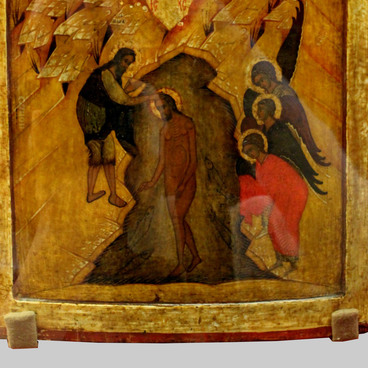The word ‘icon’ derives from the Greek eikṓn — ‘image’. It is the image of Christ or saints reproduced in accordance with canons, i.e. the rules and practises approved by the Church. Icon painting came to ancient Rus’ from Byzantium with its theological basis, iconographic definition and technique already established. In the 10th — 17th centuries, as Russian icon painters were embracing the rich Byzantine legacy and looking for new artistic methods, native schools of icon painting began to emerge. Dated to 16th century, the Old Testament Trinity is one of the earliest icons in the collection of the Gallery. In churches, it is traditionally placed in the centre of the Patriarchs tier of the iconostasis, in the upper tier of the rood screen.
The icon is based on the story of Abraham’s Hospitality from Genesis. The God made Himself present in the form of three Angels to patriarch Abraham who hosted the guests in his home and prepared a feast for them. In Greek, angelos means ‘a messenger’. The Angels told Abraham that his wife Sarah would have a son, Isaac, from whose tribe the Messiah, Jesus Christ would descend.
At the beginning of the 15th century, Andrei Rublev created a new iconographic version of the canonical depiction of the Trinity: without Abraham and Sarah. However, the icon from the collection of the Primorye Picture Gallery shows both of the subjects.
The names Old Testament Trinity and New Testament Trinity indicate the original source of the story: the Old Testament or the New Testament, respectively. The icons of the second type are deemed to be non-canonical because they depict God in a straightforward manner rather than symbolically. The decision on such division was taken at the Moscow Church Council of 1667.
The Angels on the icon from the collection of the Primorye Picture Gallery have elongated faces of Byzantine type. Their voluminous curly hair is strapped with rose blue ribbons, toroks. The Angel in the middle is the symbol of Jesus Christ. The colour scheme is dominated by warm brown, ochre, and orange tones. The artist skilfully outlined the details, with the wings, the tree trunk, the drapery, crockery and furniture hatched in strokes of gold. The composition is based on large geometric shapes.
The icon is based on the story of Abraham’s Hospitality from Genesis. The God made Himself present in the form of three Angels to patriarch Abraham who hosted the guests in his home and prepared a feast for them. In Greek, angelos means ‘a messenger’. The Angels told Abraham that his wife Sarah would have a son, Isaac, from whose tribe the Messiah, Jesus Christ would descend.
At the beginning of the 15th century, Andrei Rublev created a new iconographic version of the canonical depiction of the Trinity: without Abraham and Sarah. However, the icon from the collection of the Primorye Picture Gallery shows both of the subjects.
The names Old Testament Trinity and New Testament Trinity indicate the original source of the story: the Old Testament or the New Testament, respectively. The icons of the second type are deemed to be non-canonical because they depict God in a straightforward manner rather than symbolically. The decision on such division was taken at the Moscow Church Council of 1667.
The Angels on the icon from the collection of the Primorye Picture Gallery have elongated faces of Byzantine type. Their voluminous curly hair is strapped with rose blue ribbons, toroks. The Angel in the middle is the symbol of Jesus Christ. The colour scheme is dominated by warm brown, ochre, and orange tones. The artist skilfully outlined the details, with the wings, the tree trunk, the drapery, crockery and furniture hatched in strokes of gold. The composition is based on large geometric shapes.


